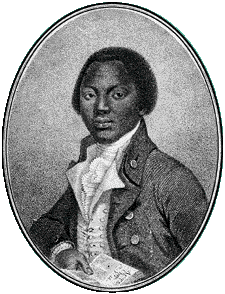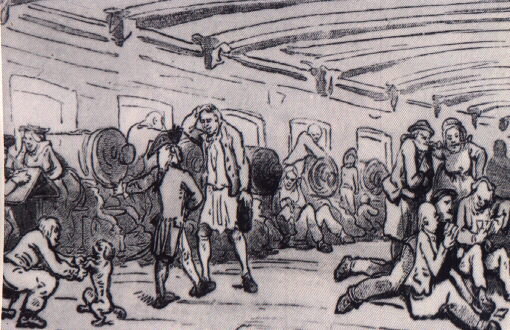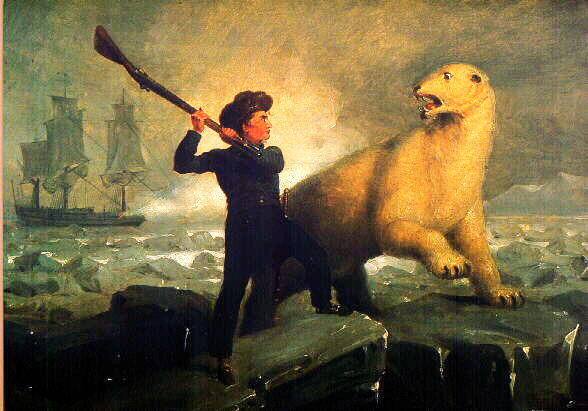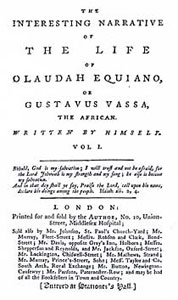Olaudah Equiano: An Illustrated Biography
 Almost everything we know about the first ten years of Equiano's life we find from Equiano's own account in The Interesting Narrative of the Life of Olaudah Equiano, or Gustavus Vassa, the African, published in 1789. In this, Equiano tells us that he was born around the year 1745 in an area called 'Eboe' in Guinea. Ibo (or Igbo) is one of the main languages of present day Nigeria. Equiano tells us that he was the son of a chief, and that at about the age of eleven he and his sister were kidnapped while out playing, and were marched to the coast and put on board a slave ship. Equiano then endured the middle passage on a slave ship bound for the New World. Equiano's accounts of Africa and the middle passage have became famous. In recent years, however, it has been suggested by Vincent Carretta that Equiano may not have been born in Africa at all. According to Carretta, Equiano may have been born a slave in South Carolina - at that time one of the thirteen British colonies in North America. Indeed, if Carretta's evidence - Equiano's baptismal records, and a naval muster roll - is accurate, there is a possibility that Equiano never visited Africa. The early parts of his autobiography may reflect the oral history of other slaves, combined with information Equiano gleaned from books he had read about Africa.
Almost everything we know about the first ten years of Equiano's life we find from Equiano's own account in The Interesting Narrative of the Life of Olaudah Equiano, or Gustavus Vassa, the African, published in 1789. In this, Equiano tells us that he was born around the year 1745 in an area called 'Eboe' in Guinea. Ibo (or Igbo) is one of the main languages of present day Nigeria. Equiano tells us that he was the son of a chief, and that at about the age of eleven he and his sister were kidnapped while out playing, and were marched to the coast and put on board a slave ship. Equiano then endured the middle passage on a slave ship bound for the New World. Equiano's accounts of Africa and the middle passage have became famous. In recent years, however, it has been suggested by Vincent Carretta that Equiano may not have been born in Africa at all. According to Carretta, Equiano may have been born a slave in South Carolina - at that time one of the thirteen British colonies in North America. Indeed, if Carretta's evidence - Equiano's baptismal records, and a naval muster roll - is accurate, there is a possibility that Equiano never visited Africa. The early parts of his autobiography may reflect the oral history of other slaves, combined with information Equiano gleaned from books he had read about Africa.
While Carretta's research opens up a very important debate, we do need to be cautious. Carretta's research strongly suggests that the young Equiano told people that his birthplace was Carolina. However, as a slave and later a recently freed slave, Equiano might have had any number of reasons to disguise his true origins. Indeed, although we can be reasonably sure that Equiano sometimes told people he was from Carolina, there is no conclusive proof that his birthplace was actually there and, until such proof emerges (if it ever does), there is no real reason to doubt the essential truth of Equiano's account of his childhood in Africa. Even if it is ever proved that Equiano was born in Carolina, it is important to stress that it is unlikely that Equiano would have invented an African origin merely to deceive the reading public. Instead, he may have included the real experience of many other slaves in his effort to make the strongest possible case against slavery and the slave trade. The truth may never be known, but click here for a summary of the main arguments on both sides of the debate.
In the summer of 1754, Equiano was sold to an officer in the Royal Navy called Michael Pascal. This can be verified independently, and we can be reasonably sure that the rest of Equiano's autobiography is an accurate account of his life. Pascal gave the boy the name of Gustavus Vassa. This was a rather cruel joke on Pascal's part. The original Gustavus Vassa was a sixteenth-century Swedish nobleman who had led the Swedish people into a war of independence from the Danes and as a result had become the first Swedish king of the Swedish people. He was thus seen as the man who had led the Swedes out of a sort of slavery. Pascal's renaming of Equiano was a typical act of slaveowners. By taking away the identity of the slave the owner was able to demonstrate the total control he had over his 'possession'.
 As Pascal's slave Equiano was introduced to the naval way of life which gave him opportunities that he would almost certainly have been denied had he been a plantation slave. For a start, he was brought to England and saw not only Europe but ultimately many parts of the world. But of greatest importance, he was able to learn to read and write which he did at a school in London where he was sent by Pascal. This was in the late 1750s when Britain was fighting the Seven Years War with France. This was essentially an imperial war, fought for control of North America and the Caribbean, and it ended in 1763 with Britain having captured Canada and a number of Caribbean islands from the French. Equiano's schooling was thus interrupted by periods at sea. There, he would have spent much of his time as a personal servant to Pascal, but in battle his part was that of gunpowder carrier, or 'powder-monkey' as he would have been known on board ship. His job was to carry gunpowder from the magazine up to the gun decks.
As Pascal's slave Equiano was introduced to the naval way of life which gave him opportunities that he would almost certainly have been denied had he been a plantation slave. For a start, he was brought to England and saw not only Europe but ultimately many parts of the world. But of greatest importance, he was able to learn to read and write which he did at a school in London where he was sent by Pascal. This was in the late 1750s when Britain was fighting the Seven Years War with France. This was essentially an imperial war, fought for control of North America and the Caribbean, and it ended in 1763 with Britain having captured Canada and a number of Caribbean islands from the French. Equiano's schooling was thus interrupted by periods at sea. There, he would have spent much of his time as a personal servant to Pascal, but in battle his part was that of gunpowder carrier, or 'powder-monkey' as he would have been known on board ship. His job was to carry gunpowder from the magazine up to the gun decks.
 We can get an idea of the crowded and informal scenes on an eighteenth-century gun deck from Thomas Rowlandson's cartoon. No naval officer would allow scenes like this on board a battleship today, but the relaxed appearance does not mean that warfare was not taken seriously. Once in battle, the crew would be expected to behave like an efficient and disciplined fighting force.
We can get an idea of the crowded and informal scenes on an eighteenth-century gun deck from Thomas Rowlandson's cartoon. No naval officer would allow scenes like this on board a battleship today, but the relaxed appearance does not mean that warfare was not taken seriously. Once in battle, the crew would be expected to behave like an efficient and disciplined fighting force.
During this war Equiano saw action in Canada and in the Mediterranean and, by now having fought for the British and having been baptised, Equiano quite reasonably felt that he was entitled both to his share of the prize money that was handed out to sailors on naval vessels, and to his freedom. However, he was cheated of his money and then suddenly sold to another sea-captain who took him to the island of Montserrat in the Caribbean, where he was sold again to a Quaker by the name of Robert King. Equiano's first fear was that he would be sent into the plantations, but by now he was a very well-educated slave and therefore much too valuable to be sent into the fields. King had him trained as a gauger - someone who gauges weights and measures - which was a very responsible position, something rather like a quality control manager today. While Equiano was in Montserrat he witnessed the worst tortures imaginable being inflicted on his fellow slaves and this experience, he tells us, gave him an added incentive to achieve his freedom. He was in the fortunate position that he could exploit his job to his own advantage and, after three years, in 1766, he saved up £40, the price of his own freedom. In his autobiography he writes movingly about his great joy at gaining his freedom. After a short while he went back to England.
On his arrival he was finally paid his wages from the navy. He had less luck with Captain Pascal who continued to refuse him his prize money. He worked for a while as a hairdresser, but this didn't pay very well, so he went back to sea, on most voyages either as a hairdresser or a steward. He took what were seemingly a couple of very pleasant cruises around the Mediterranean, and then a voyage back to the Caribbean, before in 1773 joining a voyage of exploration. This voyage took place under the command of John Phipps and the idea was to find a passage to India across the North Pole. This wasn't just a scientific project. The discovery of a north-west passage would save British ships a great deal of time and would thus considerably strengthen Britain's imperial claims on India. Equiano shipped aboard the Racehorse, and the expedition was soon joined by another ship: the Carcass. One of the crew on this ship was a young midshipman named Horatio Nelson. Nelson was later to become the great hero of the battle of the Nile and the battle of Trafalgar. On this journey he was almost killed in an encounter with a polar bear, here imagined by Richard Westall in his painting of 1809.
 Equiano isn't shown in the picture, but we get an idea of some of the dangers he faced on this voyage. Indeed, the Racehorse was almost lost, but the mission was a scientific success in that it was clearly proved that a north-west passage would not be found.
Equiano isn't shown in the picture, but we get an idea of some of the dangers he faced on this voyage. Indeed, the Racehorse was almost lost, but the mission was a scientific success in that it was clearly proved that a north-west passage would not be found.
Equiano returned to London where two things of note occurred. First, he became involved in the political and legal efforts to outlaw slavery and the slave trade. This came about because a former slave and a friend of his, John Annis, was kidnapped by his former owner who wished to have him sent to the Caribbean. This was in 1773. In the preceding year this practice had been declared illegal by Lord Mansfield. Equiano went to Granville Sharp, the first prominent British abolitionist, for help and between them they tried to save Annis, but unfortunately their attempt was unsuccessful. However, Equiano was now in contact with the most important British campaigner against slavery. The other important thing which takes place at this time was Equiano's conversion to Christianity. He had been exploring the scriptures and examining his own faith for some time, but it was on a voyage to Spain that he tells us that he saw 'the bright beams of heavenly light' and was 'born again'. To many secular twentieth-century readers this has seemed like the least important part of his narrative, and in some editions of The Interesting Narrative the section describing Equiano's conversion is cut out entirely. But to many readers in the eighteenth century - and, of course, to Equiano himself - this really was the key moment of his life.
Equiano then went out to the Caribbean again, in 1775, and this time he became involved in a project to set up a new plantation - or colony - on the Caribbean coast of Central America, probably in present day Nicaragua. This 'adventure' seems somewhat problematic to us today as Equiano was involved in two projects which are specifically associated with European colonisation. First of all he appoints himself as a Christian missionary, hoping that he can bring Christianity to the native Americans in the area. Secondly, he and his associates buy slaves to work on the plantation and Equiano is clearly involved in this at a high level, although he is at some pains to point out that he did 'every thing I could to comfort the poor creatures, and render their condition easy'. We have to remember that in the mid 1770s there was as yet no organised anti-slavery movement and, indeed, there were very few individuals who thought that slavery should or even could be abolished outright. There were, however, a growing number of people who argued that just because people were slaves it didn't mean that they should be treated cruelly. These people sought to ameliorate the conditions of the slaves by stopping corporal punishment, and by making sure the slaves had access to decent housing, food and medical care. Equiano can be placed with the ameliorationists at this point, although clearly he is not yet an abolitionist.
His experiences on leaving this colony might have helped him to change his mind about this. Once again he was cheated of money he was owed and - more dangerously - a slave-owner tried to re-enslave him. He was strung up for several hours and only managed to escape in canoe. Once again he decided to go back to London, where he worked for seven years as a servant (with a couple of cruises to America) before getting involved with the Sierra Leone resettlement project. This part of his narrative is dealt with in just a few pages, but historians of slavery view this project as being a very important one, not least because it took place at the same time as the very early period of the abolition campaign. Essentially, what happened was that in 1786 a number of people, particularly a rather eccentric amateur botanist by the name of Henry Smeathman, noticed that there were a great number of unemployed Africans begging on the streets of London. Smeathman reasoned that, since these people had been brought to England from Africa against their will in the first place, the kindest thing would be to round them all up and send them back again. The opinion of the Africans concerned was not asked for. While it is easy for us to be judgmental about this scheme now, we have to remember that, at the time, many of the most committed anti-slavery campaigners, such as Granville Sharp, were fully behind this because they genuinely believed it to be a work of charity. Sharp in particular was keen to make sure that the colony which was set up in Sierra Leone would be run along lines of equity and justice and that slavery would be outlawed there. Equiano believed in the project too, and he was given the job of Commissary of Provisions and Stores - it was his job to buy the food and equipment which the ships and the colony would need - a job which made him probably the first black civil servant in England. He soon found out, however, that corrupt officials were siphoning off the money to line their own pockets and that as a result there would not be enough provisions to keep the colony going until its first harvest. He drew attention to this in several places, but the enlightened attitude of the government in employing a black civil servant did not last and institutional racism quickly kicked in. The Navy Board stood up for him, but he was sacked nonetheless. And he was absolutely right about the Sierra Leone colony. Precisely because it was so badly provisioned only 60 of the 374 people shipped there survived the first four years.
 His next project was to write the book on which his fame rests. When The Interesting Narrative appeared, in the spring of 1789, it was at the height of the popular campaign to abolish the slave trade and his was one of over a hundred books to appear that year on the subject of slavery. In the main it was given good reviews, but the reviewers were in no doubt that this was a book of the moment. The Gentleman's Magazine, for example, said that
His next project was to write the book on which his fame rests. When The Interesting Narrative appeared, in the spring of 1789, it was at the height of the popular campaign to abolish the slave trade and his was one of over a hundred books to appear that year on the subject of slavery. In the main it was given good reviews, but the reviewers were in no doubt that this was a book of the moment. The Gentleman's Magazine, for example, said that
Among other contrivances (and perhaps one of the most innocent) to interest the national humanity in favour of the Negro slaves, one of them here writes his own history, as formerly another of them published his own correspondence.That other one was Ignatius Sancho. So these reviewers saw the book as political propaganda. Is this a fair assessment? In a way it is. Right at the end of the book, Equiano lays out a number of religious and economic arguments for the abolition of slavery, and the presence of these arguments has a strongly politicising effect on the book. Firstly, they make a straightforward political point - that the slave trade should be abolished - and back up that point of view with evidence. Secondly, their structural position in the narrative - last - ensures that these arguments are the ones which are uppermost in the mind of the reader when he or she lays down the book, and they also bring together many of the more local arguments against slavery which are made throughout the course of the book. We might remember, for example, the descriptions of the cruel treatment of slaves in Montserrat and Nicaragua. Yet one of the most important political aspects of the book is very similar to that of The Letters of Ignatius Sancho. Sancho's editor claimed that one of her motives for publishing his letters was 'the desire of shewing that an untutored African may possess abilities equal to an European'. We could argue that Equiano was doing the same when, right at the start of his book, he lays out his motives:
If it affords any satisfaction to my numerous friends, at whose request it has been written, or in the smallest degree promotes the interest of humanity, the ends for which it was undertaken will be fully attained, and every wish of my heart gratified.When Equiano refers to 'humanity' he seems to have several things in mind. Firstly he of course means that slavery is inhumane in that it is a cruel business resulting in a great deal of human misery. He is calling for its abolition. But as well as the overt anti-slavery agenda there is a more subtle anti-racist project going on to dispel some of the racist myths current in eighteenth-century England. Amongst these was an increasingly widespread myth that Africans were either not fully human or were of a less developed branch of humanity. Part of Equiano's project is to dispel this myth entirely by showing the world that he, in common with all human beings, is quite capable of writing a fine book describing a life which would be considered extraordinary and full of talent and seized opportunity regardless of the racial origins of the person who had lived it.
In this respect, we can say that the project of writing autobiography is, in Equiano's case, a strongly political act. Indeed, the book is a rather special sort of autobiography: a black self-representation. In this period this is in itself somewhat unusual, but the work is also an account of the life of a former slave, a particular genre which is known as a 'slave narrative'. By 1789 a very small number of these had already appeared, mostly oral accounts spoken by a slave or former slave and taken down and published by white amanuenses (although a famous exception to this is the Thoughts on Slavery published in 1788 by Equiano's friend Quobna Ottobah Cugoano). But Equiano's narrative was very different from most of those that had gone before. Not only had he written it himself, but he had also published it himself, by subscription, a method which involved getting people to put the money up front. He managed to convince many very important people to pay in advance for his book, a list which starts with the Prince of Wales and includes no less than eight dukes. Equiano's book is different in another way too. Equiano did not just publish the book and leave it to fend for itself. Instead, he vigorously promoted it by going on lecture tours around England, Scotland, Wales, and Ireland, and by promoting his book he was also promoting the idea of abolition of slavery. Indeed, it was local abolition committees who arranged the lectures and readings at which he was present. During the early 1790s, then, Equiano had not just turned his life story into a document opposing slavery, but had transformed his entire life into a sort of anti-slavery document.
Equiano spent much of the 1790s campaigning against slavery, but he also managed to turn his book into a financial success as well. The 1790s brought personal changes too, and on 7 April 1792 he married an Englishwoman, Susanna Cullen, at Soham in Cambridgeshire. Olaudah and Susanna had two daughters, one of whom survived to inherit a substantial estate of £950 from her father (equivalent to about £100,000 or $160,000 today). Equiano died in March 1797, a full ten years before the slave trade was abolished in British ships, forty years before slavery was abolished in British colonies, and 68 years before slavery was ended in the United States. Although Equiano did not live to see these events, his narrative played an important part in bringing them about.
Text © Brycchan Carey 2000-2005
Much of what we know about Olaudah Equiano's life comes from his autobiography, The Interesting Narrative of the Life of Olaudah Equiano, or, Gustavus Vassa, the African
Equiano's Interesting Narrative was published in nine different editions between 1789 and 1794. Following the author's death, it appeared in several unauthorised nineteenth-century editions before going out of print until the 1960s. The book is now available in several editions, including a paperback edition with notes, index, and an introduction, edited by Brycchan Carey and available from:
